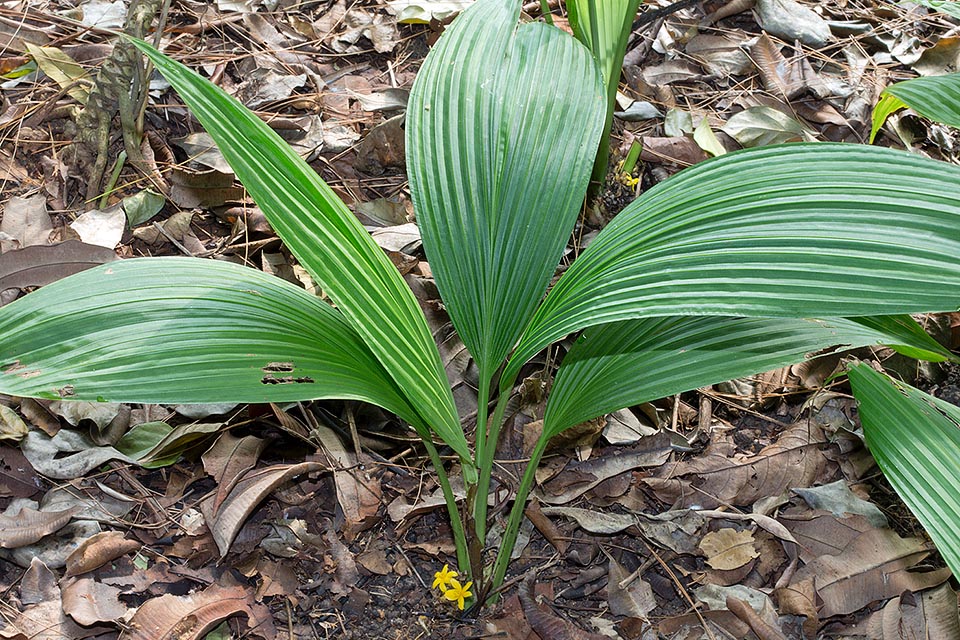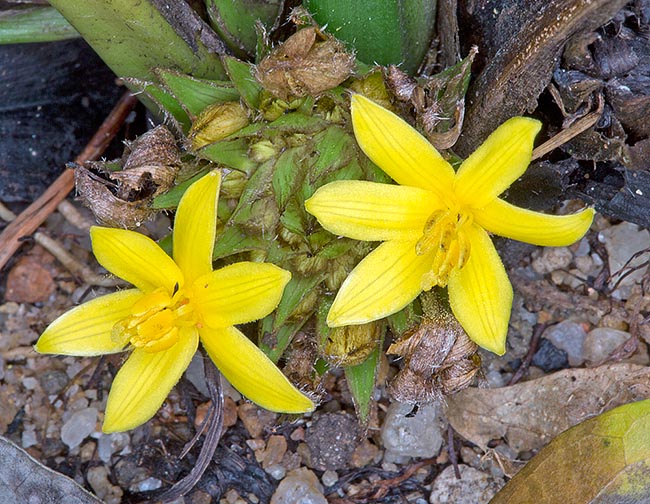Family : Hypoxidaceae

Text © Pietro Puccio

English translation by Mario Beltramini
The species is native to Andaman Islands, Bangladesh, Borneo, Cambodia, China (Anhui, Fujian, Guangdong, Guangxi, Hainan, Henan, Hong Kong, Hunan, Jiangsu, Jiangxi, Kin-Men, Macau, Ma-tsu-Pai-chúan, Shanghai and Zhejiang), Java, Nicobar Islands, Malaysia, Myanmar, Philippines, Sulawesi, Sumatra, Thailand and Vietnam where it grows in the underwood of the humid forests close to water streams, from the sea level up to about 1000 m of altitude.
The genus is honoured to the Italian botanist Ignazio Bernardo Molineri (1741-1818); the specific name is the combination of the Latin adjective “latus, a, um” = wide and of the substantive “folium, ii” = leaf, with obvious reference.
Common names: palm grass, weevil lily (English); doyo, kehoang, ketari, lekuan, lumpa, luva, marasi, merap (Indonesian); lamba, lemba, lumbah, pinang puyuh (Malaysian); chaa laan, ma phraao, phraa nok (Thai); cồ nốc lá rộng, sâm cau lá rộng (Vietnamese).
The Molineria latifolia (Dryand. ex W.T.Aiton) Herb. ex Kurz (1865) is a perennial herbaceous species, acaulescent, evergreen, provided of an erect rhizome and creeping stolons. The leaves, on an up to 0,5 m long petiole, are basal, simple, plicate, lanceolate to oblong lanceolate with pointed apex, entire margin and parallel venations, 15-60 cm long and 5-12 cm broad.

Native to South-East Asia, Molineria latifolia is an acaulescent, perennial herbaceous species, rhizomatose with 15-50 cm leaves and even 60 cm long petiole. The fruits are ovoid 2-4 cm berries, they modify about one hour after eating, the perception of sweet: in fact also tapwater seems then sugary. In 1990 they have found that it depends on a protein, the neoculin, a sweeter 500 times stronger than saccharose. Pity for obese that it’s thermolabile © Giuseppe Mazza
Axillar racemose inflorescences at the level of the soil on a short erect scape, compact, ovoid to cylindrical, of 2-6 cm of length and of diameter, with sessile or subsessile intense yellow flowers coming at the axil of green bracts almost triangular with pointed apex, the lower ones are hermaphroditic, the upper ones male, with 6 oblong tepals with pointed and retroflexed apex, about 1 cm long. The flowers last only one day and are pollinated by ants and bees. The fruits are white ovoid barries, 2-4 cm long and of 1-2 cm of diameter, with “beak” (extension at the apex) 0,6 cm long, edible, containing tiny blackish seeds.
It reproduces by seed, that, if fresh, germinates easily in organic draining loam maintained constantly humid at the temperature of 24-26 °C, by divsion and through root suckers.
Species suitable to the tropical and humid subtropical zones, where at times is cultivated in parks and gardens thanks to the ornamental leaves, and marginally in the temperate-warm ones, where temperatures of around the 0 °C are short lasting exceptions. It requires partially shaded to shaded exposition and fertile, well drained soils, rich of organic substance with ample availability of water.

Axillar racemose 2-6 cm inflorescences at soil level. Ephemeral flowers with 1 cm tepals. Medicinal virtues © Giuseppe Mazza
The fruit, sweet, has also the property to modify, for about one hour after the consumption, the perception of the taste of the water and of the foods and bitter drinks that are perceived as sweet, in acidic as well as in alkaline ambient, it is not therefore a sweetener, but a taste modifier, however hypocaloric.
This property is due to the neoculin, a protein, isolated in 1990, that has an average sweetening power about 500 times bigger than that of the saccharose and up to more than 2000 times, in function to the acidity of the substance in contact with the tongue. This protein has the handicap of being thermolabile, the effect disappears for temperatures exceeding the 50 °C, therefore is not suitable for warm foods and drinks.
The leaves are utilized by the local populations for wrapping foods and, particularly in Borneo, for getting from them the fibres, strong, elastic and highly resistant to the fungal attacks, therefore suitable for warm-humid locations, with which are done ropes, fishing nets and fabrics replacing the cotton.
All parts of the plant are variously utilized in the traditional medicine for various pathologies; laboratory studies have evidenced the presence of bioactive compounds having promising antioxidant and microbial properties of possible use in the official pharmacopoeia.
Synonyms: Curculigo latifolia Dryand. ex W.T.Aiton (1811); Curculigo sumatrana Roxb. (1814); Aurota latifolia (Dryand. ex W.T.Aiton) Raf. (1837); Molineria sumatrana (Roxb.) Herb. (1837); Molineria longiflora Kurz (1864); Curculigo villosa Wall. ex Kurz (1869); Molineria plicata Kurz (1869); Molineria villosa Kurz (1869); Curculigo latifolia var. glabrescens Ridl. (1907); Curculigo agusanensis Elmer (1913); Curculigo brevipedunculata Elmer (1913); Curculigo weberi Elmer (1913); Curculigo borneensis Merr. (1922); Curculigo glabrescens (Ridl.) Merr. (1922); Curculigo senporeiensis Yamam. (1934).
